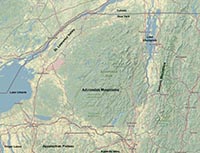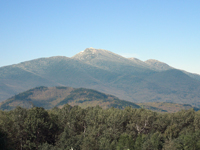|
The Adirondack Mountains is a large dome-shaped uplift, about 160 miles wide with more than 100 peaks distributed through the region (Figure 46a & b). The bedrock is more than a billion years old, formed during the Grenville Orogeny in Late Precambrian time (Proterozoic). Metamorphic rocks, once buried many miles in the crust. Unusual rocks including anorthosite and marble are now exposed; minerals mined in the region include garnet, graphite, wollastonite, graphite, magnetite, and hematite. In contrast, the dome itself is very young—rising in the region starting about 5 to 10 million years ago. The region has risen nearly 7,000 feet with erosion stripping away the sedimentary cover. The mountain region is still rising.
The Adirondack Mountains were overrun by the Laurentide glaciers of the Pleistocene Epoch that moved south out of Canada. The glaciers stripped away the sedimentary cover. Late in the Pleistocene as the great continental glaciers restricted, alpine glaciers continued to shape the landscape, creating features including horns, cirques, U-shaped valleys, and other glacial features. |

Fig. 46a. Map showing the location of the Adirondak Mountains in northern New York. |

Fig. 46b. Algonquin Peak is one of the highest peaks in the Adirondack Mountains in upstate New York. |
